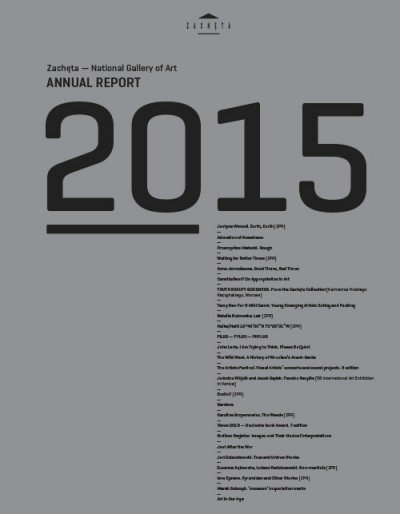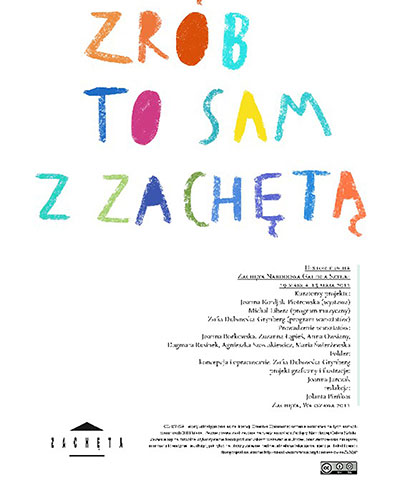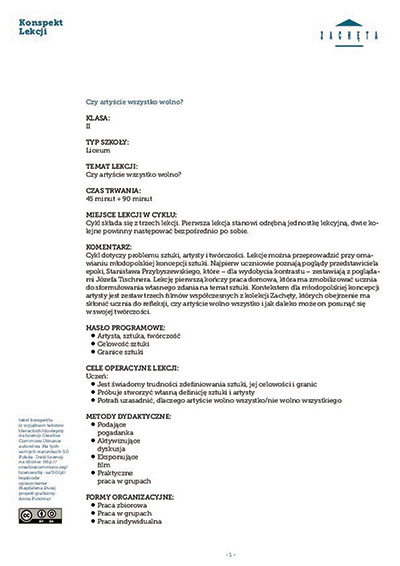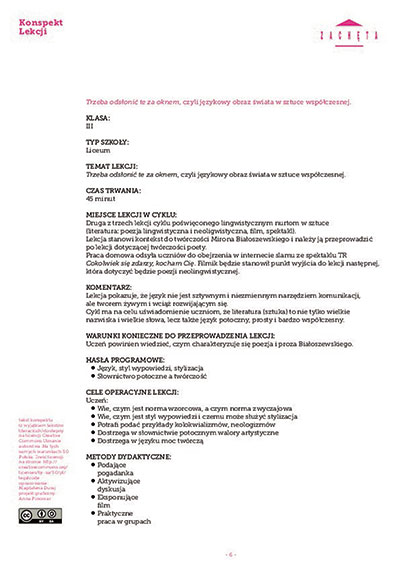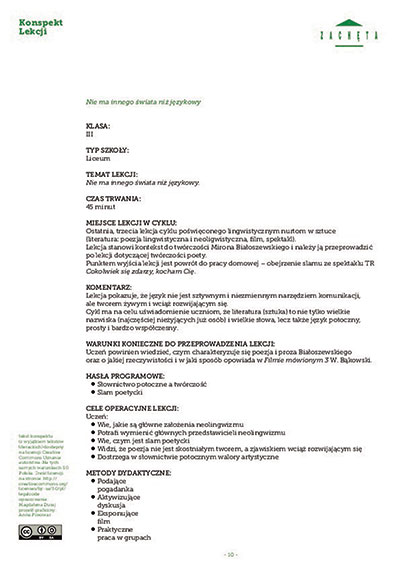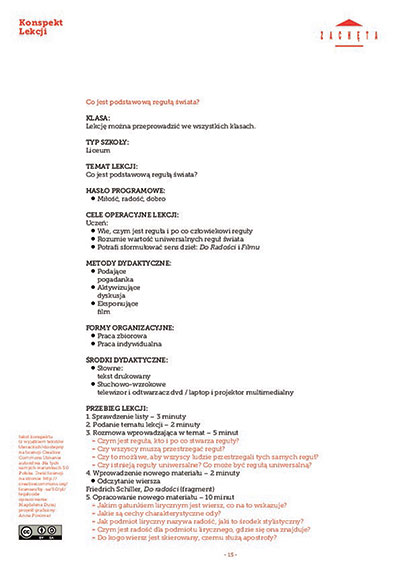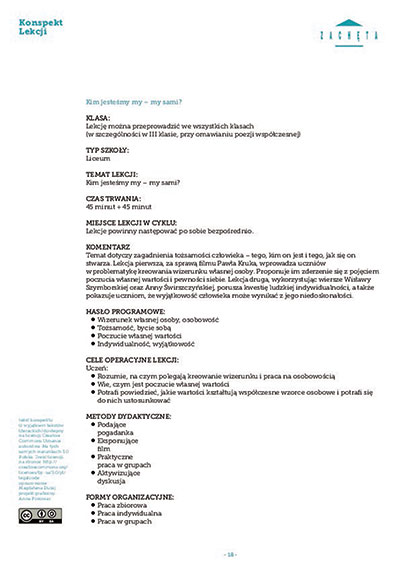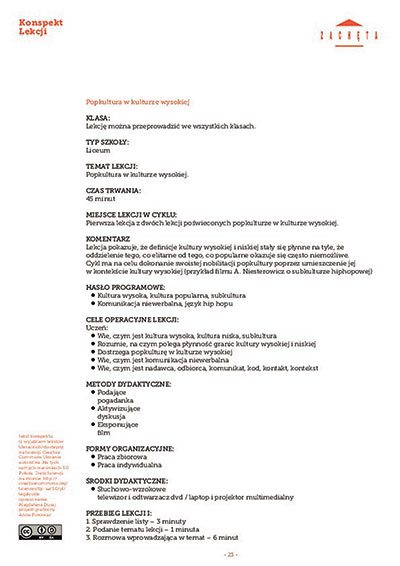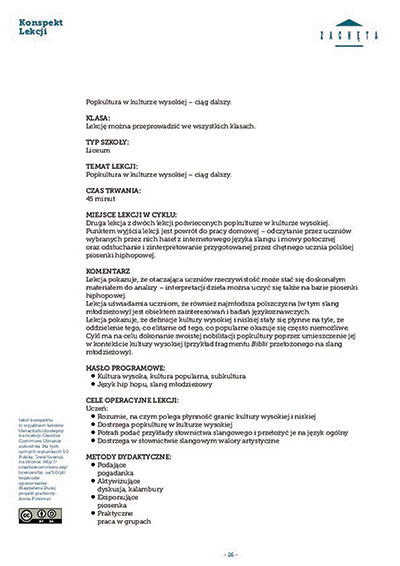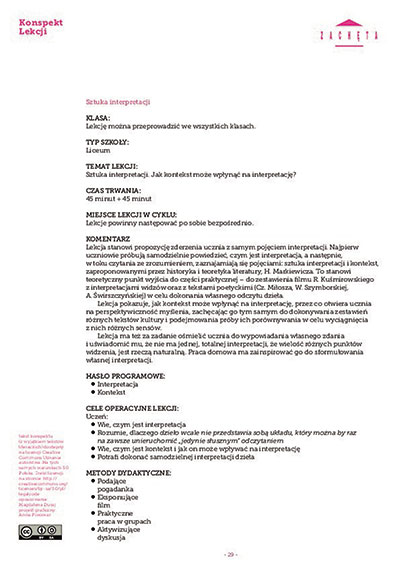Publikacja udostępniana jest na licencji Creative Commons.
Publication date: 29.07.2020
Two women stand close together, tossing a small ball between each other. There. And back. And back again. It looks like there’s no end to this . . . game? It also doesn’t seem to be bringing them much joy. It seems a bit obsessive. Girls, looking at the camera, show different points on their bodies. Instructions? But for what? A young woman sits with her head tilted back; the hands of someone outside of the frame hold up her head; or are they holding it down? Help or violence? What is going on in these photographs and videos and why, even though they are not drastic, are they disquieting?
The Ambiguity of Power
Help or violence? This ambiguity is at the heart of power. Power is not really just what we associate with the word when we use common sense. ‘When we speak of power, it is spontaneously conceived of as law, as interdiction, as prohibition and repression; and we are quite disarmed when we follow it in its mechanisms and in its positive effects.’[1]
Power, meanwhile, is not the same as institutions such as the state, the law or the police; it is not a set of rules and norms that prohibit or forbid. This is because it does not limit something that would have already existed — our desires or unorthodox forms of subjectivity — but it produces this subjectivity and those desires, while at the same time shaping and regulating them through systems of interrelated discourses and practices: medicine, clinics and hospitals, psychiatry and hospitals for the mentally ill, law, police and prisons. A prohibition, if one appears, is something secondary.
Thus, ‘power is not simply what we oppose but also, in a strong sense, what we depend on for our existence and what we harbour and preserve in the beings that we are.’[2] We have ‘always’ been entangled in power; there is no way out of it — there is no area of pure freedom where power is simply absent. For Judith Butler, this entanglement is linked to an infant’s primal dependence and the love for the caregivers it forces on the child: ‘there is no possibility of not loving, where love is bound up with the requirements for life.’[3] Because this love is born in conditions of extreme inequality and dependence, it is susceptible to abuse — ‘the desire to survive, “to be”, is a pervasively exploitable desire’.[4]
This does not mean that resistance is impossible. Power is a field of strategic relations enabling certain individuals to influence the actions of other individuals. This influence can be hostile and oppressive, but it can also be beneficial. A primary school teacher obviously not only know more than the children they teach, but also has the task of, in addition to conveying information, to instil in them the self-discipline necessary for learning. The process can take on an oppressive form (which the school as an institution often enables), but it can also bring out the children’s creativity, curiosity and initiative. Likewise, the ‘invention’ of homosexuality by 19th-century sexology pioneers made the people assigned this label the object of attention of doctors and police, but also enabled homosexuals to fight for their rights on the basis of this very identity.[5]
Foucault draws attention to the need to distinguish between power and domination; power relations are mobile, reversible and susceptible to change, often freeze, creating hierarchies that are immune to transformation; ‘power relations, instead of being mobile, allowing the various participants to adopt strategies modifying them, remain blocked, frozen.’[6]
Resistance to dominance understood in this way does not take the form of a search for an external territory of freedom, but of working on power relations ‘from within’, of trying to dynamise them. If power is everywhere, so is resistance and freedom. However, they take on a form as complex and ambiguous as power — they are never ‘pure’, they carry the stigma of being entangled in states of domination from which they emerge and from which they want to free themselves.
Family — a Curse and a Blessing
Nowhere does this reveal itself as clearly as in the case of family — the basic building block of society to which most of us are condemned for better or worse, if only because it has shaped us in our childhood; it is the subject of the photographs from the Frowst series. Although the nuclear family, made up of a married couple and their children, emerged relatively recently — more or less in the 19th century[7] — many representatives of 20th-century humanities and even science[8] have naturalised it, considering it an eternal, permanent environment in which human subjectivity is shaped. Tales of human evolution or the functionalist psychology and sociology of the 1950s presented the nuclear family as both a basic fact that allowed for the explanation of specific human characteristics, and a normative point of access, an ideal of socialisation to which everyone should aspire. The fact that the majority of real families did not measure up to this ideal has been the reason for constant academic interventions by psychologists and socialists, therapists and social workers. Family happiness was presented as the ultimate fulfilment — the more attractive the more real families deviated from the ideal.
The greatest contribution to the mythicisation of the family was probably made by psychoanalysis. Sigmund Freud’s vision of the developing subject created in response to the inability to satisfy the drives that turned towards objects from their closest surroundings — generally, the parents — placed the individual permanently in the horizon of private relations of the nuclear family, which in psychoanalytic optics appears as much as a blessing as a curse, but above all as an impassable territory defining the nature of the desire not only of the child, but also the adult. The fact that Freud’s theory not only did not meet contemporary scientific standards, but also those of his time[9] makes little difference in terms of the cultural influence of psychoanalysis. Despite its unscientific nature, it expresses the fears and desires of people shaped by capitalist modernity — it is a powerful myth of this era.
This myth resists being unmasked and shown as unscientific; however, this does not mean that discussion with it should be avoided. It is a reflection of the modern changes that gave the family the form we know today, as well as created the private individual. It is, however, a distorted reflection, presenting these historical processes as an expression of eternal forces that cannot be fought against. In this way, it reinforces the aforementioned discourse about the ahistoricity and necessity of the nuclear family, making it impossible to see that it is not our fate.
However, exposing psychoanalysis as unscientific from a positivist perspective has limited effectiveness. Interpersonal relations and the social sciences and humanities that deal with them only partly belong to the field of rationality and remind us that we are not strictly rational beings. This does not mean, however, that the domain of unreason to any myth that succeeds in gaining popularity; however, the critique of myths must take place in part in their own territory.
Although Freud’s ‘discovery’ of the unconscious remains extremely important to contemporary humanities, the discoverer himself, as well as his successors, have done much to erase its radical character.[10]Freud defined the unconscious as subordinate to insatiability, scarcity and the threat of castration (which Lacan would later reinterpret as a symbolic castration, necessary for the subject to constitute itself). Despite the assumption of plasticity of desire, Freud decided that it was doomed to fit into gender roles defined by the society in which he lived.
The family and the individual subject, as well as the primacy of the Oedipus complex and castration remain the main point of reference and model for psychoanalysis, including in situation when its representatives attempt to analyse social and political phenomena.[11]This makes psychoanalysis not so much diagnose the entanglements of subjects as perpetuate them, taking the sides of fathers, the patriarchy and heteronormativity: ‘Reading the history of culture in a way that aligns a patriarchal psychology with civilization, we see its discomfort or neurosis as the price we have to pay.’[12]
Thus, it is good to assume that investments in what is social and political precede the creation of a subject and investments in the choice of the object defined by the family context. This does not mean that the mechanisms described by Freud do not exist. Rather, Freud and orthodox psychoanalysis do not perceive what happens within the unconscious on a level preceding the castration and the Oedipal selection of the object. ‘Castration! Castration! cries the psychoanalytic scarecrow, who never saw more than a hole, a father or a dog where wolves are, a domesticated individual where there are wild multiplicities.’[13]Although in a capitalist society, the family makes a power appropriation of desire, it is neither natural not necessary. The ‘defamilisation’ of the unconscious, however, turns out not to be a simple matter, as evidenced by the example of feminism and its fight against patriarchy, far from being over.
Feminism and the Challenge of Unreason
Despite several hundred years of women’s struggle for equality and the unquestionable achievements in this field, we are still far from overthrowing the patriarchy. Formal equality, the right to education and competition in the labour market were not enough to eliminate the inequalities that have existed for thousands of years. Every feminist offensive meets with a counterattack — the current attack of the extreme right on reproductive rights and women’s rights in general is just the latest part of this conflict.[14] Emancipating women constantly face a wall of prejudices resistant to rational argumentation and formal, legal reforms. This is because the patriarchy is not rational — although the justifications that cite its naturalness and roots in the human unconscious take the form of rational, scientific argumentation, they are only justifications of emotions and attitudes that are not.
This is why feminism faces a difficult task: it must transform the structures of the unconscious, the area of unreason, resistant to law and reason. For this reason, ‘reasonable’ people looking at it from the outside often criticise its inappropriateness and excessive radicalism, suggesting that feminists are not successful because of their aggression or inappropriate tone. Behind such remarks lies the outrage of scandal of revealing the hierarchies that structure our supposedly democratic society. As Jacqueline Rose puts it, the task of feminism is ‘to push us all too far, by bringing to the surface those secrets of history and of the heart which most fiercely, and fatally, resist the light’.[15]
Feminism is therefore confronted with an area of ambivalence, with the power that oppresses us as much as it calls us into existence. This is well illustrated by the issue of stories of women’s trauma, which are a particular sub-genre of public confessions. Apart from fighting for changes in legislation or exposing prejudices, they are an integral part of feminist politics. Describing women’s experience, devoid of means of expression in the patriarchy, is an emancipatory practice, which shows the role of consciousness raising in the development of the second wave of feminism.[16] In turn, the #MeToo movement showed that personal confessions about the harassment experienced, if there are enough of them, can bring about social changes on a large scale.
However, there is a danger to using stories of injustice as a political tool. As Mary Beard points out, drawing a parallel between the ancient ban on women speaking in public and the still existing aversion to women moving about in the public sphere, ‘there are only two main exceptions in the classical world to this abomination of women’s public speaking’.[17] One of them is speaking on behalf of women as a particular group. In the second, ‘women are allowed to speak out as victims and martyrs, usually to preface their own death’.[18]Modern feminists do not intend to commit suicide, unlike Lucretia, who obeyed the patriarchal norms — they use the convention of speaking about their own harm to take a place in the public sphere and transform it. Despite this radical use, however, stories of harassment, rape or domestic violence remain burdened with the history of past, not necessarily emancipatory uses.
Foucault points out that confession was the main institution of Western Christian culture, creating the subject, making them credible and at the same time visible.[19] It granted an identity that could become the basis for fighting for one’s own rights, but at the same time offered truth of the subject of power. Confession, therapy and statements politicising the personal experience or identity (such as coming out or consciousness building) are therefore developments of one ambivalent convention. In the case of women’s stories about a true, most often traumatic, experience, this means becoming entangled in a mechanism that links the word of a woman with the status of a victim, which can result in permanent victimisation and the inability to transform it into agency. There is also a risk that the act of making a statement will become a sexualised spectacle — the aforementioned convention links political statements with representations of women who have been raped or driven mad, present in patriarchal literature or visual culture, constituting the object of unhealthy fascination. And even if this does not happen, the statement can simply be considered as an expression of a woman’s subjective feelings, to which, as Rebecca Solnit states, women’s statements are often reduced; they are ‘credible’ only in the sense that they convey the emotions of the speaker, without in any way reflecting reality.[20] This is an effective way to neutralise them.
This does not mean, of course, that the political use of the trauma narrative must end in failure and be reduced to previous patterns. However, the relation to them means that this practice remains forever marked by ambivalence and entanglement in power relations. In this context, the role of art suspending the issue of the credibility of a confession and questioning the conventions of speaking about trauma proves particularly promising.
Anti-spectacle
In one of her interviews Joanna Piotrowska distanced herself from photographers ‘fascinated by how something looks rather than interested in what that thing means’.[21] The Frowst series refers to family photographs[22]; however, unlike them, it does not present a scrubbed clean, official image of the family, free from all peculiarities and tensions that characterise relations between its members. The staged (the artist’s relatives and friends served as models) representations of people whose actual status remains a mystery to us, but in whom, by the power of convention, we see family members, are inappropriate and disturbing. The photographed people are too close, they assume uncomfortable, unnatural poses, or remain embraced or intertwined in an uncomfortable way (the fact that they are often not fully dressed does not help). When we think of a modern family, the suggestion of incest — its threat, its supposedly universal ban, the ultimate transgression it represents — always remains on the horizon. For capitalist modernity, the family is a model of human relations supposedly untouched by the self-interest we have to show by competing with each other in the market, and which provides a respite from that competition. At the same time, its actual functioning and the success of the therapeutic industry, which is supposed to correct its deficiencies, show that the burden on the family to provide authentic, close emotional connections puts it under enormous pressure, with which it cannot cope. That is why we often have the impression that the family home is full of frowst — even if the relatives are not clearly incestuous, their relationships are often too close, burdensome, full of tension, ‘unhealthy’.
The second important context for Frowst is, as the artist herself points out, the tradition of documentalism — individual photographs are only marked with Roman numerals, and the lack of colour brings to the foreground the forms and arrangements of the photographed subjects.[23] The impression of severity and authenticity clashes with the knowledge that although we have ‘real’ relatives before our eyes, we do not know their history and do not know whether they are really linked by the relations suggested in the pictures. This is important in the context of another reference important for the cycle — the Bert Hellinger family constellation method.[24] It is based on the assumption that recreating the system in which the living and deceased members of the family remain together, releasing the related emotions and forgiving the abusers should have a healing effect on an individual. The constellations take the form of spectacular sessions, during which the participants, who take on the roles of the members of the patient’s family, are supposed to experience the same emotions by virtue of being in their place within the constellation. As critics point out, this effect is achieved by means of suggestion to which those who choose this form of assistance are vulnerable.[25] They also stress that Hellinger’s concept of the ‘knowing field’ responsible for the constellations is pseudo-scientific in nature, and the method itself does not meet the ethical standards for therapists, due, among other things, to its manipulative nature.[26] Nevertheless, Hellinger’s method remains artistically attractive[27], probably because of its drama, its ‘performative logic’.[28] This is because it enables the transformation of problematic human relations into abstract constellations, which can then be subjected to various transformations showing the mechanisms that produce these constellations and how they can be dismantled. Joanna Piotrowska does this not only in Frowst, but also in works with the working titles of Self-defence and Sensitive Points. The former shows poses from a self-defence handbook made in the absence of the attacker; this lack of reference makes them just as strange as the arrangements in Frowst, We do not see the attacker, just as we do not see the patriarchy shaping and haunting the bodies of women assuming the poses, as much oppressing them as giving them an identity; however, their presence is visible in unnatural and awkward poses that betray the tension of the models. The girls in the Sensitive Points film and photos show the places on the body most vulnerable to attack. Thus, they demonstrate their own vulnerability, turning it into a cool, abstract show.
This is important in the face of the aforementioned mechanism of transforming women’s suffering (as well as suffering generally caused by, for example, domestic violence) into a spectacle. If one wanted to find one term for these works, it would be anti-spectacular: Piotrowska takes performances about women’s family entanglements and oppression out of the context of personal narratives, appealing to equally personal emotions and influencing through empathy. Such a reaction is simply not possible with Frowst or Sensitive Points. Stanley Wolukau Wanambwa considers this a kind of weakness or defect, commenting: ‘these photographs, abandoning autobiography in favour of a performative variety of therapy, transform emotions into rootless abstraction. They show the illness without the patient, and the power of their fiction makes us immune to the disturbing psychology they so eloquently express.’[29] I think that this immunisation frees us from the ‘visceral’ emotional reaction to stories of family trauma, which can force us to stay with the initial shock without making us think.
To start thinking about power, we need not so much emotional identification as a cool metacommentary — it is provided by all the artist’s works, but probably the most important is the film Animal Enrichment which presents the models’ interactions with mysterious objects (used to stimulate animals, but the viewers do not need to know that); as they are taken out of their original context, these objects resemble strange fetishes or disciplinary tools. They force women to take repetitive actions which seem (because of the expressionless models’ faces) laced with obsession or aggression. Discipline and desire are closely linked to each other, and they create a subject in the course of successive repetitions, ensuring obedience, but also creating the possibility of repetition, which will include deviation, difference.
Works that appeal to emotions would not bring this mechanism to the surface —instead of the illness, they would make us focus on the patients and their individuality. Piotrowska’s photographs and films depicting an ‘illness without a patient’ suspend the reality of power relations, a procedure analogous to the phenomenological epoché —a reduction of the assumptions about the way the world or object exists, which allows it to be reconstructed in the right way. The artist’s works make such a reduction, reaching the pure form of power, or, to put it more in Marx’s terms, ‘determinate abstraction’[30] which creates a ‘concrete’ of family life and patriarchal conditions, not as unique and special as the convention of confession suggests. This treatment denaturalises power without underestimating its effectiveness.
Joanna Bednarek — philosopher, translator, writer, member of the editorial office of Praktyka Teoretyczna; her texts have been published, among others, in Teksty Drugie, Krytyka Polityczna and Czas Kultury. Author of books, among others, Linie kobiecości. Jak różnica płciowa przekształciła literaturę i filozofię? (2016), Życie, które mówi. Nowoczesna wspólnota i zwierzęta (2017) and O pochodzeniu rodziny (2018).
[1]Michel Foucault, ‘The West and the Truth of Sex’, in SubStance, no. 20, vol. 6/7, 1978, pp. 5–8, DOI:10.2307/3684633.
[2] Judith Butler, The Psychic Life of Power. Theories in Subjection, Stanford: Stanford University Press, 1997, p. 3.
[3] Ibid, p. 8.
[4] Ibid., p. 7.
[5] Michel Foucault, ‘Sex, Power, and the Politics of Identity’, in Essential Works of Foucault 1954–1984, ed. Paul Rabinow, Harmondsworth: Penguin Books, 2001, pp. 163–173.
[6] Michel Foucault, The Ethics of the Concern of the Self as a Practice of Freedom, in ibid., p. 214.
[7]Jean-Louis Flandrin, Historia rodziny, trans. Agnieszka Kuryś, Aletheia, Warsaw 2015, pp. 7–18 [orig.: Familles. Parenté, maison, sexualité dans l'ancienne société, 1976].
[8] An overview and criticism of these theories can be found in the following works: Elaine Morgan, The Descent of Woman, New York: Stein and Dein, 1972; The Woman That Never Evolved, Cambridge: Harvard University Press, 1999; Donna Haraway, Primate Visions. Gender, Race and Nature in the World of Modern Science, New York–London: Routledge, 1989.
[9] Michel Onfray, Le crépuscule d'une idole: l'affabulation freudienne, Paris: Bernard Grasset, 2011; Frederick Crews et al., The Memory Wars: Freud’s Legacy in Dispute, New York: New York Review of Books, 1995, pp. 31–73; Rebecca Solnit, ‘Cassandra Among the Creeps’, in Men Explain Things to Me, updated edition, Chicago: Haymarket Books, 2015.
[10] Gilles Deleuze, Felix Guattari, Anti-Oedipus, Minneapolis: University of Minnesota Press 1983; A Thousand Plateaus, Minneapolis: University of Minnesota Press, 1987.
[11] The Jungian collective unconsciousness does not break with this assumption because it does not really have a social character — it is an ahistorical resource of patterns expressed primarily in the individual unconsciousness; interpretation of social phenomena using Jung’s perspective (e.g. Clarissa Pinkola Estés, Women Who Run with the Wolves, New York: Ballantine Books, 1992) does not differ significantly from similar interpretations made using the Freudian or Lacanian perspective and relies on projecting mechanisms described in relation to an individual onto the collective.
[12]Carol Gilligan, Joining the Resistance, Cambridge, UK: Polity Press, 2011.
[13]Gilles Deleuze, Felix Guattari, p. 38.
[14] Klementyna Suchanow, To jest wojna. Kobiety, fundamentaliści i nowe średniowiecze, Warsaw: Agora, 2020.
[15] Jacqueline Rose, Women in Dark Times, London–New York: Bloomsbury, 2014, p. 192.
[16]Sara Evans, Personal Politics. The Roots of Women’s Liberation in the Civil Rights Movement and the New Left, New York: Vintage, 1980.
[17] Mary Beard, Women and Power. A Manifesto, London: Profile Books 2017, p. 13.
[18] Ibid.
[19]Michel Foucault, Rządzenie żywymi, trans. Michał Herer, Warsaw: PWN, 2018, p. 309, 321 [orig: Du gouvernement des vivants, Paris: EHESS, Gallimard, Le Seuil, 2012]; Hermeneutyka podmiotu, trans. Michał Herer, PWN, Warszawa 2014, pp. 300–305 [orig.: L'Herméneutique du sujet (1981–1982), Paris: Gallimard, 2001].
[20]Rebecca Solnit, ‘A Short History of Silence’, in The Mother of All Questions, Chicago: Haymarket Books, 2017, p. 45.
[21] Joanna Piotrowska, Evita Goze, ‘Interview with Joanna Piotrowska’, FK Magazine, https://fkmagazine.lv/2015/03/13/interview-with-joanna-piotrowska/, accessed: 13.08.2020.
[22] Anca Rujoiu, Reflections on Frowst, https://photoworks.org.uk/frowst/, accessed: 13.08.2020.
[23] Ibid.
[24]‘Joanna Piotrowska. FROWST— recenzja’, https://www.fotopolis.pl/opinie/recenzje/16808-joanna-piotrowska-frowst-recenzja/25410/37565,accessed: 13.08.2020.
[25] Małgorzata Talarczyk, ‘Ustawienia metodą Berta Hellingera — kontrowersje’, Psychoterapia, no. 4(155), 2010; Bartosz Zalewski, ‘Ustawienia rodzinne Hellingera — szkodliwa szarlataneria?’, https://www.swps.pl/strefa-psyche/blog/relacje/18620-ustawienia-rodzinne-berta-hellingera-szkodliwa-szarlataneria, accessed: 13.08.2020.
[26] Małgorzata Talarczyk, pp. 30–32; Bartosz Zalewski.
[27] It was also used in Anna Baumgart’s film Fresh Cherries (2010), devoted to women forced into prostitution in concentration camps; see Paweł Możdżyński, ‘Bezdroża nieświadomości zbiorowej.O Świeżych wiśniach Anny Baumgart’, https://www.asp.wroc.pl/dyskurs/Dyskurs15/Dyskurs15_PawelMozdznski.pdf, accessed: 13.08.2020.
[28]Stanley Wolukau Wanambwa, ‘Developmental deficits.Joanna Piotrowska’s Frowst’, https://www.thegreatleapsideways.com/?ha_exhibit=developmental-deficits-joanna-piotrowskas-frowst, accessed: 13.08.2020.
[29] Stanley Wolukau Wanambwa.
[30] Paolo Vinci, ‘Abstrakcja określona’, in Marks. Nowe perspektywy, ed. Libera Università Metropolitana, trans. Sławomir Królak, Warsaw: PWN, 2014 [orig. ‘Astrazione determinata’, in Lessico Marxiano, Roma: Manifestolibri, 2008]; the matter at hand is abstraction, from which one has to depart in order to understand the concrete in all its complexity; this abstraction appears as a result of material forces (for example, abstract work has appeared thanks to the capitalist way of production).
-
18.09 – 06.12.2020Joanna PiotrowskaFrowst
Joanna Piotrowska’s first comprehensive monographic exhibition in Poland presents a selection of her works from the past few years. In her staged photos and videos, the artist focuses on exploring human relationships and their bodily expression.
Zachęta – National Gallery of ArtZachęta


